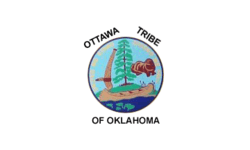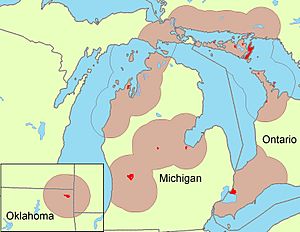Ottawa Tribe of Oklahoma facts for kids

official tribal flag
|
|
| Total population | |
|---|---|
| 2,500 | |
| Regions with significant populations | |
| United States (Oklahoma) | |
| Languages | |
| Ojibwe (Ottawa dialect), English | |
| Religion | |
| Christianity, traditional tribal religion | |
| Related ethnic groups | |
| other Odawa tribes, Potawatomi, and Ojibwe |
The Ottawa Tribe of Oklahoma is one of four officially recognized Native American tribes of Odawa people in the United States. Their ancestors, who spoke an Algonquian language, slowly moved from the Atlantic coast and Great Lakes areas. By the 1700s, they had reached what is now Michigan and Ohio.
In the late 1830s, the United States government used a policy called Indian Removal. This policy forced the Ottawa people to move west of the Mississippi River. First, they went to Iowa, then to Kansas. This area was known as Indian Territory. After the Civil War, in 1867, they sold their land in Kansas. They moved again to buy land in another part of Indian Territory, which later became northeast Oklahoma. The U.S. Congress allowed them to buy land from the Quapaw tribe, who were the main tribe in that area.
The other three Ottawa tribes are in Michigan. This state is part of the traditional Odawa homeland. These tribes are the Grand Traverse Band of Ottawa and Chippewa Indians, the Little River Band of Ottawa Indians, and the Little Traverse Bay Bands of Odawa Indians. There are also First Nations (Native groups) of Odawa people in Ontario, Canada. Some live on Manitoulin Island, which is their original homeland.
Contents
Tribal Government and Leadership
The main office for the Ottawa Tribe of Oklahoma is in Miami. Their special area of authority is in Ottawa County. In the early 2000s, the tribe had 2,500 registered members. About 737 of these members live in Oklahoma. To become a member, you must be a direct descendant of a tribal member. There is no minimum blood quantum (a measure of Native American ancestry) required.
The tribe is led by a Business Committee. Here are some of the current leaders:
- Chief: Ethel Cook
- Second Chief: Kalisha Burtrum
- First Councilman: John Charles Dawes
- Second Councilman: Mikal Scott-Werner
- Treasurer: Mary King
Former Chief: Charles [Red Cedar] A. Todd (1935–2014) was a respected former leader. He served in the U.S. Army during the Korean War and was a decorated combat veteran. He was on the tribal council from 1983 to 2008 and served as Chief from 1999 to 2008. Chief Todd was a descendant of earlier Ottawa leaders, including Chief Joseph [Badger] King and Chief Pontiac.
The Ottawa Tribe is working to update its Constitution. This important document guides how the tribe is governed.
Tribal Businesses and Economy
The Ottawa Tribe works hard to create jobs and support its members. They issue their own special tribal vehicle tags (license plates). The tribe runs several businesses, including two tribal smoke shops and two gas stations. They also have the Otter Stop Convenience Store and the Adawe Travel Plaza.
A big part of their economy is the High Winds Casino. In 2021, the tribe opened its first restaurant, called the Otter Cove Diner. The Oklahoma Indian Affairs Commission estimates that the tribe's businesses bring in about $3 million each year. This money helps support tribal programs and services.
Culture, Language, and Community Programs
The Ottawa Tribe is dedicated to keeping its culture and language alive. They have a Community Health Program and the Healthy Living Center in Miami. These programs help tribal members stay healthy. They also have a Department of Environmental Protection to care for the land.
The tribe publishes the Adawe News, a newspaper for its members. This helps everyone stay connected and informed. They also offer classes to teach the Ottawa dialect of the Ojibwe language. This helps younger generations learn their traditional language.
The Ottawa Tribe of Oklahoma holds an annual powwow every Labor Day weekend. A powwow is a special gathering where Native American people celebrate their culture through dancing, singing, and socializing.
History of the Ottawa People
The name "Ottawa" or "Odaawaa" comes from the word Adaawe. This word means "to trade." The Ottawa were well-known among other tribes as important traders even before Europeans arrived. The French quickly saw how influential they were. They used the Ottawa as middlemen to trade with tribes further north and west. These tribes supplied furs from the 1600s into the 1700s.
The Ottawa are part of the Three Fires Confederacy. This is a historic alliance with the Ojibwe and Potawatomi tribes. The Ottawa in Oklahoma are descendants of groups that moved south from Manitoulin Island and the Bruce Peninsula. Both of these places are in Ontario, Canada. They moved because of pressure from the Iroquois and other tribes, and as Europeans moved into their lands. They settled near Fort Detroit and the Maumee River in Ohio.
Forced Relocation and New Beginnings
The United States government pressured the Ottawa to move again. This happened after Congress passed the Indian Removal Act in 1830. This law allowed the government to exchange land with Native American tribes. The goal was to move them from east of the Mississippi River and take their land titles there. The Ottawa groups from the Blanchard's Fork, Roche de Bœuf, and Auglaize reserves in Ohio signed a treaty with the U.S. in 1833. They gave up their lands in Michigan, Ohio, and Illinois. In return, they received lands in Iowa, then Kansas. This was part of the Indian Territory plan.
The Ottawa did not leave Ohio until April 1837. About 600 Ottawa people moved to Kansas. Sadly, "more than 300 died within the first two years." This was due to harsh conditions, lack of proper food, and the big difference between the cool, damp forests of Ohio and the dry, hot plains of Kansas.
To ensure their survival, the tribe made a very important investment in their children's future. The Ottawa controlled 74,000 acres (300 km²) of land in Kansas. They set aside 65 acres (0.26 km²) for a higher-level school. They also sold 20,000 acres (81 km²) of land to pay for building and maintaining the school. This school, Ottawa University, was connected with the Baptist Church. It educated both Native American and non-Native students. Today, Ottawa University still offers free tuition to any registered member of the Ottawa tribe.
The town of Ottawa, Kansas, grew because of the Ottawa Reservation. The Ottawa people stayed in Kansas until 1867, after the American Civil War. Under the leadership of Chief John Wilson, the tribe sold their lands in Kansas. They bought 14,863 acres (60.15 km²) of land in Indian Territory from the Eastern Shawnee. More tribal members died during this move. Only about 200 Ottawa people arrived in their new lands.
Changes in Federal Policy
Two decades later, Congress passed the Dawes Act of 1887. This law aimed to encourage Native Americans to live like European-Americans. It broke up communal tribal lands and governments. It required that communal lands be divided into 160-acre plots for individual households of registered members. This happened for each tribe in the Indian Territory. In many areas, the land was so poor that 160 acres was not enough for a family to farm and survive. In 1891, 157 Ottawa families finally received their plots of land in Indian Territory. The U.S. government then declared the rest of their land "surplus" and sold it, mostly to non-Native buyers. The Dawes Rolls are records of tribal members registered at that time. Many tribes use these rolls to confirm membership from that period.
In 1936, the Ottawa tribe in Oklahoma reorganized their government under the Oklahoma Indian Welfare Act. They officially gained federal recognition as a tribe again. This gave them certain benefits, such as in education.
However, in the 1950s, federal policy changed once more. Congress decided to encourage tribes to give up their special status with the federal government. This was called the termination policy. The Ottawa of Oklahoma were one of the tribes whose federally recognized government was terminated in 1956. This meant they lost important benefits and their society was disrupted. The tribe worked hard to regain their status. Federal recognition was restored when President Jimmy Carter signed a bill on May 15, 1978. In 1979, the U.S. Congress recognized the tribal council and approved their tribal constitution.
In 1980, the Grand Traverse Band of Ottawa and Chippewa Indians gained federal recognition. In 1994, two more Odawa tribes in Michigan also gained federal recognition: the Little River Band of Ottawa Indians and the Little Traverse Bay Bands of Odawa Indians. There are also official First Nations (Native groups) of Odawa people on Manitoulin Island and in other parts of Ontario, Canada.
Today, the Ottawa Tribe continues to serve its community. They provide free lunches for elders in the town of Miami.


